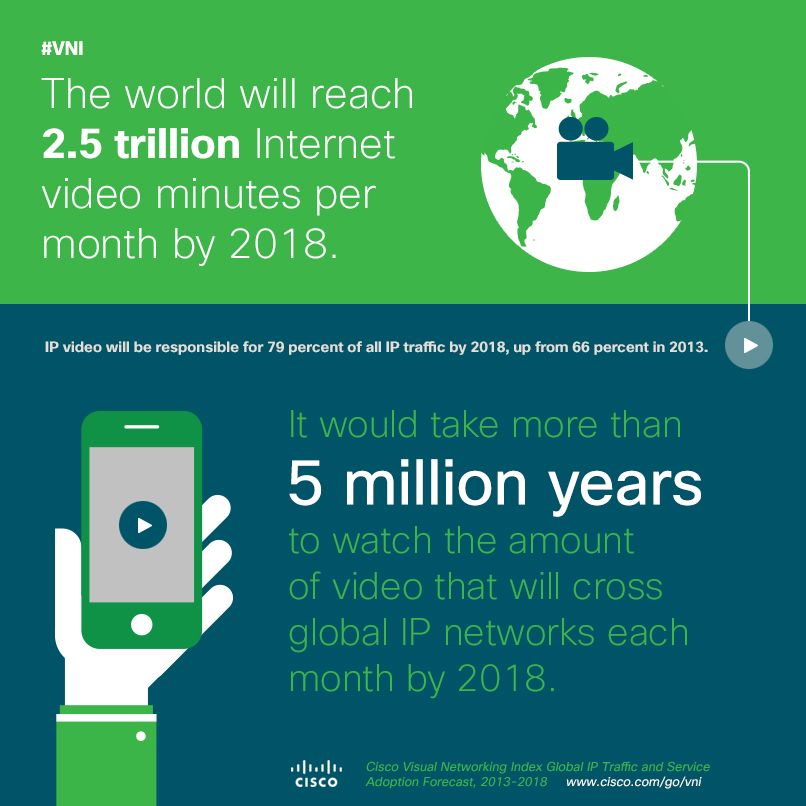































Over the past two decades, Internet Protocol (IP) traffic has been on the rise and is anticipated to continue along a similar trajectory over the next five years. The increasing number of fixed and wireless devices and M2M nodes that are connecting to global IP networks is one of the primary contributors to global IP traffic growth. According to the Cisco's Visual Networking Index? Global Forecast and Service Adoption for 2013 to 2018, global IP traffic will increase nearly three-fold over the next five years. The growing number of Internet users and faster broadband speeds are also contributing to this traffic growth. However, another trend likely to increase global IP traffic is the increased use of video applications - online video streaming, live video feeds and video on demand (VoD), as well as various forms of video communications.
The Growth of IP Video
The world will reach 2.5 trillion Internet video minutes per month by 2018. That is nearly5 million years of video per month, or 1 million video minutes every second, or nearly two years' worth (657 days) of video every second.

Cisco's VNI projects that IP video will be responsible for 79 percent of all IP traffic by 2018, up from 66 percent in 2013. Of that, high definition (HD) video will generate more traffic than standard definition (SD) video. Residential, business and mobile consumers continue to have strong demand for advanced video services across all network and device types with quality of service, convenience, and price as key factors for success. Continued business video adoption, such as HD and web-based video conferencing and business video on demand (VoD) may prompt greater growth in network virtualization and leveraging the Internet for video transmission with network ramifications for service providers and over-the-top providers.
Propelled by the availability of low-cost, high-resolution connected devices, consumers have rapidly bypassed the 'novelty' phase of TV everywhere turning acceptance into expectation. Additionally, Internet video to TV will continue to grow at a rapid pace, increasing fourfold by 2018. Internet video to TV traffic will be 14 percent of consumer Internet video traffic by 2018, up from 11 percent in 2013. With the emergence of popular video-streaming services that deliver Internet video to the TV and other device endpoints, content delivery networks have prevailed as a dominant method to deliver such content.
IP Video Global Trends
It would take an individual more than 5 million years to watch the amount of video that will cross global IP networks each month in 2018. Service providers are faced with evolving bandwidth and scalability requirements as residential, business and mobile consumers continue to require advanced video services across a variety of networks and devices. IP networks must be intelligent and flexible enough to support this tremendous variety of traffic growth.
The increasing number of wireless devices worldwide that are able to connect to the Internet via mobile networks is a primary contributor to global IP video growth trends. Cisco is helping prepare service providers for the multi-faceted IP traffic growth, as projected by Cisco's VNI. In my next blog, I'll explore content delivery networks (CDN) and IP traffic topology. For more information about Cisco's IP traffic forecast, refer to "Cisco VNI: Forecast and Methodology, 2013-2018" and visit the other resources and updates at the VNI page.
If you have any questions, please tweet us @CiscoVNI.
 Tags quentes :
Service Provider
visual networking index
network virtualization
ip traffic
ip video
Video On Demand
NetFlix
Content delivery networks
global ip traffic
Tags quentes :
Service Provider
visual networking index
network virtualization
ip traffic
ip video
Video On Demand
NetFlix
Content delivery networks
global ip traffic